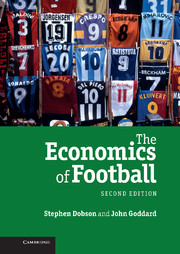Book contents
- Frontmatter
- Contents
- Preface
- Acknowledgements
- List of figures
- List of tables
- 1 Introduction
- 2 The economic theory of professional sports leagues
- 3 Competitive balance, uncertainty of outcome and home-field advantage
- 4 Forecasting models for football match results
- 5 Game theory and football games
- 6 English professional football: historical development and commercial structure
- 7 Determinants of professional footballers' salaries
- 8 Professional footballers: employment patterns and racial discrimination
- 9 The football manager
- 10 The football referee
- 11 Spectator demand for football
- 12 Gambling on football
- 13 Football around the world: France, Germany, Brazil, Japan and China
- 14 The economics of the World Cup
- References
- Index
6 - English professional football: historical development and commercial structure
Published online by Cambridge University Press: 05 June 2012
- Frontmatter
- Contents
- Preface
- Acknowledgements
- List of figures
- List of tables
- 1 Introduction
- 2 The economic theory of professional sports leagues
- 3 Competitive balance, uncertainty of outcome and home-field advantage
- 4 Forecasting models for football match results
- 5 Game theory and football games
- 6 English professional football: historical development and commercial structure
- 7 Determinants of professional footballers' salaries
- 8 Professional footballers: employment patterns and racial discrimination
- 9 The football manager
- 10 The football referee
- 11 Spectator demand for football
- 12 Gambling on football
- 13 Football around the world: France, Germany, Brazil, Japan and China
- 14 The economics of the World Cup
- References
- Index
Summary
Introduction
Professional football as a sport has always been inextricably linked to its attributes as a business, but never more so than during the modern era. Complaints are aired regularly in the media and elsewhere that players are overpaid; that the transfer market is out of control; that the whims of wealthy owners are driving many clubs to penury; that exorbitant ticket prices are driving spectators away from football; and that the priorities of television are dictating both the strategic and the operational decisions of football clubs and the sport's organising bodies.
Chapter 6 presents an overview of the historical development of English club football as a business, and analyses its current economic, financial and commercial structure. Section 6.1 describes the competitive structure of the major league and cup tournaments in which English teams participate, and identifies historical trends and patterns in the performance of groups of teams distinguished by characteristics such as geographical location, city size and date of entry into the league. Section 6.2 describes trends in match attendances, and the explanations for changing patterns of attendance that have been proposed by historians, sociologists and economists.
Section 6.3 provides an overview of the profitability or loss-making propensities of English football clubs. The following three sections describe historical and current trends in the main revenue and cost items that appear in a football club's profit and loss account: namely gate revenues, examined in Section 6.4; broadcast revenues, examined in Section 6.5; and expenditure on players' wages and salaries, and transfer expenditure, examined in Section 6.6.
- Type
- Chapter
- Information
- The Economics of Football , pp. 139 - 196Publisher: Cambridge University PressPrint publication year: 2011



